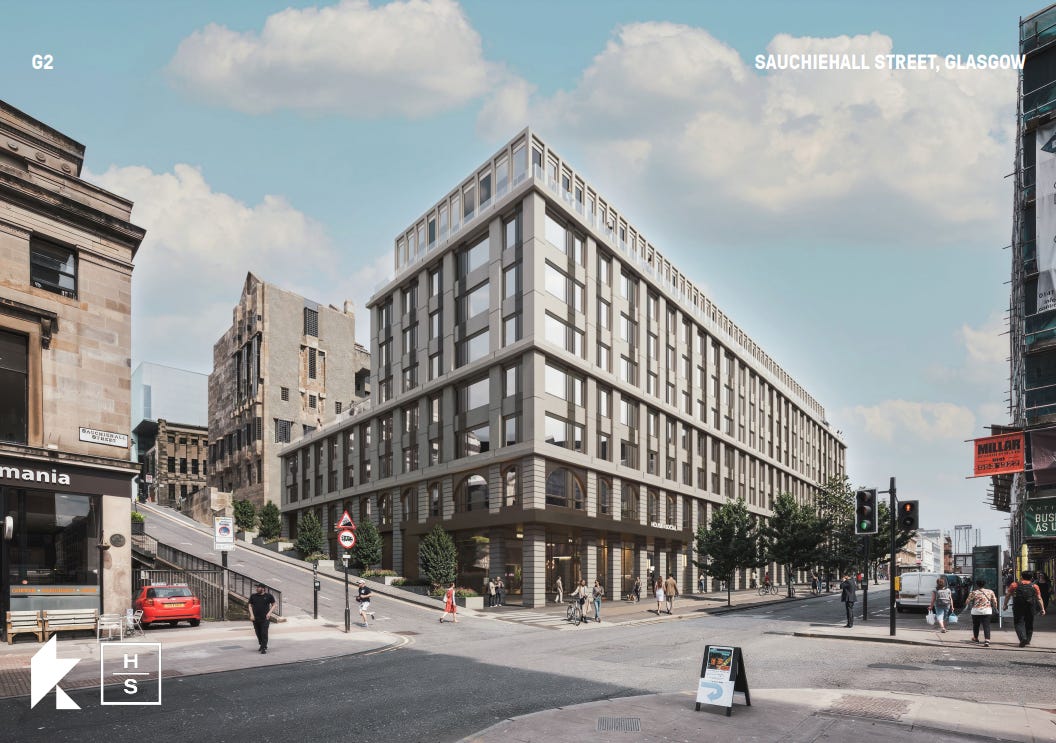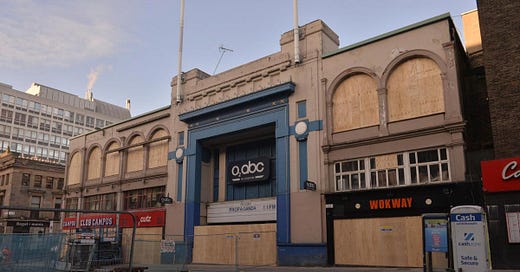A fire, a sauce boss and a student development firm: Can the O2 ABC be saved?
Total demolition of the O2 ABC was given the green light last week, sparking a fierce debate over salvaging the historic former cinema.
It was a balmy night in June 2018 when crowds of revellers stood in clusters, enthralled by the horror of flames and smoke gushing from the Glasgow School of Art for the second time in four years. The fire spread to neighbouring buildings, tearing through the roof of the historic O2 ABC and licking at the sides of Jumpin Jaks nightclub. It took the tireless work of more than 120 firefighters to extinguish. The remains of the buildings smouldered for days.
At first, the loss of the O2 ABC was overshadowed by the second fiery blow to the Mackintosh Building. But the ruin of one of the city’s most important music venues was devastating. “It won’t be the end of the venue. The venue will eventually reopen,” concert promoter Paul Cardow told Daily Record at the time. “At the moment, we are just waiting to hear when. The venue will have to undergo extensive rebuilding but that will happen.”
Dating back to 1875, the O2 ABC had many lives over the years but was always a place of mass entertainment for Glaswegians. Known first as the Diorama, then the Panorama, it was converted into Hubner’s Ice Skating Palace in 1885. Three years later, it was the first building in the city to have electricity. It went on to become the home of Hengler’s Circus as the Hippodrome before an extensive renovation in 1929 gifted the city with the building seen today. The art deco entrance portico was built by architect Charles McNair with a cast iron glazing screen by Walter Macfarlane & Co at the Saracen Foundry, a miniature of the façade seen at Selfridges in London. It operated as an Associated British Cinemas (ABC) chain until its conversion into a music hall for the new millennium.
A fierce battle has arisen from the ashes of the tragic 2018 fire over the conservation of the city’s heritage. On one side, the Northern Irish owners of the O2 ABC and the English student development company Vita Group seeking total demolition of the site to convert it into purpose-built student accommodation. On the other, politicians and conservationists who want to see plans redrawn to save the street-facing elevation and entrance foyer of the beloved venue. The degraded state of the building and whether the portico can be saved has been the topic of fierce debate.
Despite local will to see the O2 ABC returned to the people as a music venue after the fire, owners first sought to demolish the category C-listed building in 2019. Structural engineers described the venue as “beyond repair” and “economically unsalvageable”, earmarking it for demolition in 2019 despite over 12,000 residents signing a petition to call for it to be saved. At the time, council officials agreed that the application to demolish the building could be put on hold until it was supported by a proposal for a replacement building.
A few months later in July 2019, a separate structural appraisal and condition survey was completed by a top Conservation Accredited Engineer at David Narro Associates. It found that despite extensive damage to the building, which was already deteriorating due to prolonged exposure, the main structure was salvageable, and that restoration was feasible at that time.
But owners left it open to the elements for six years after the blaze. Glasgow City Council finally slapped the former cinema with a Dangerous Buildings Notice in early August this year. On August 20, OBARCS ABC Ltd. was finally granted listed building consent to demolish it and make way for student accommodation that has long been planned for the site.
Based in Northern Ireland, the building is in the property portfolio of mayonnaise magnates Trevor Kells and Michael Haddock, who recently sold their firm Rich Sauces to French company Solina. They did not respond to requests for comment on why the building had been left exposed.
Since being given the green light for demolition, owners now have until December 9 to tear down the landmark. A council planner stated, “full or partial retention of the building is not viable” and a building standards official told the planning committee that owners are “legally obliged” to comply with the Dangerous Building Notice. A condition for the owners to take “all reasonable steps to salvage materials from the demolished building for reuse, repurposing and recycling” is attached to the consent.
Those who have watched the building decay before their eyes are angry. “I’m depressed and frustrated because we originally objected to the planning application to demolish the building in 2019,” says Gordon Barr of ScottishCinemas.org. “It was the owner’s claim at that point that the building was absolutely beyond repair and in danger of falling into the street. Here we are five years on and it’s still standing. It’s more solidly built than people give it credit for.”
The complete lack of effort to cover the building and prevent water ingress is also frustrating, he adds.
Vita Group, the development company behind plans to erect purpose-built student accommodation and a food hall on the site, released drawings in February 2024 for a fully demolished site that included no façade retention or homage to the iconic O2 ABC. The firm says they won’t know the extent of what they can save from the frontage until demolition begins.
MSP Paul Sweeney says the prospect of the historic cinema being completely demolished is both frustrating and depressing. “This has cut me deep on a personal level.”
He has been campaigning for Vita Group to save the O2’s entrance portico, which was built as a solid concrete stand-alone structure. “What’s really angered me is that I was told by planning consultants representing Vita that it was nothing more than a stage set that had been made with plasterboard and timber – that it was completely flimsy and couldn’t be retained because it was so fragile.”
The Labour politician spoke to the heritage-accredited engineer behind the 2019 report that stated the building could be salvaged. “He looked at the recent photographs that were submitted in evidence to the planning committee by building control and drone footage that was done over the weekend [before the planning meeting on August 20] and concluded that there was nothing substantially structural that had changed that merited demolition. And certainly not with the urgency that’s been suggested by the Building Control Department.”

Fellow conservationists want every effort to be made to save the portico “in situ” and not just “salvaging bits of it”. Those who want to save the front of the building are at loggerheads with the council over its condition and structural integrity.
If Vita Group does not make every effort to save the building’s frontage, they are “wilfully demolishing and destroying a piece of the city’s heritage”, Sweeney added. “I’m absolutely livid about it.”
Vita Group declined to comment. A spokesperson for the firm said their intentions to salvage what they could from the structure were made clear in the planning meeting.
A spokesperson for the council responded: “The report [to the planning committee] highlights multiple and complex structural issues with O2 ABC, including the façade, following the fire in 2018 and subsequent exposure to the elements over the past six years.
“Our report highlights the extensive damage to the different structures connected to the façade and that these structures must be removed as part of wider work to make safe the entire premises.
“The Committee was advised that until demolition work is commenced it will not be possible to assess fully what part of the façade, if any, can be saved and re-used where possible.
They added: “The O2 ABC was a key element of the cultural scene on Sauchiehall Street and we will work with the building owners to preserve as many elements of the façade as feasible.
“Our staff are suitably qualified and experienced to work with structural matters and heritage buildings.”
Sweeney wants Vita to enlist the David Narro Associates engineer and see if he can devise a way to preserve the O2 ABC’s façade in situ and work it into a new building.
“I think that’s a good compromise,” he said. “I’m not asking for the whole venue to be preserved as much as I would like that. But I think that the front element of the entrance part is a perfectly reasonable thing. It would fit neatly into the scheme with some minor adjustments. They might lose a handful of bedrooms from their project but that’s a small compromise to save a piece of the city’s heritage that is so much loved.”
Councillor Ruairi Kelly, convenor for neighbourhood services and assets, said: “[Vita Group] has committed to engaging with the council’s new Built Heritage Commission and other heritage organisations within the city to arrive at the best outcome we possibly can for retaining whatever can be salvaged from it or recognising the cultural importance that the O2 had.”
Kelly, who like many had his first Glasgow night out at the O2 ABC, said he is committed to speaking with the engineer at David Narro Associates about the potential to save what they can of the O2’s façade and arched portico to have it incorporated in the designs.
“Whatever we can do to save that we will. But the demolition order being issued by building control, it’s not something that councillors have a remit or authority over.
“My preferred outcome is that we do some form of façade retention on the front. If that’s not feasible then I want to ensure that as much of the portico is saved as possible and reused either internally or in the back courtyard.
“I think the worst outcome is that the site lies burnt out and vacant for another five or 10 years. Of all the outcomes, that’s the worst one.”








